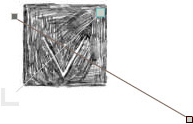
It seems fitting that the editorial statement for a multimedia journal should itself be enacted in a dynamic form. Yet text continues in many ways to provide us with the means for our clearest form of expression. Thus, we commend this editorial statement to you as a hybrid introduction and metaphor for beginning to experience some of the ideas and pathways that weave their way throughout Vectors. This editorial "statement" attempts in part to represent the multiple collaborations and conflicts that take place in interactive and computational media, highlighting not only the virtual dialogue between creator and producer, but also the tenuous alliance of human and machine intelligence. To launch the statement, simply click the image above.
One of the primary and ongoing tensions in an academic multimedia journal is the question of how to deal with text. This is not a new question nor is it one that is peculiar to electronic publishing. One of the ways of dealing with text in a screen-based vernacular is to think of it as an instance of images. Usually this is marked by the shift from plain text to typography, which broadens the expressive palette to include fonts, layout, color, composition, contrast, opacity, dynamism, etc. Instead of treating text as images, we decided to explore — through our collaboration with Vectors Creative Director Raegan Kelly — what happens when we treat written text as an instance of code - more rather than less like the way the computer understands it.
The statement thus became a three-way conversation between us, Raegan, and the computer, seeking to create an environment where the words that we wrote were not necessarily privileged over Raegan's programming or the output generated by the computer. The three output windows thus reflect the parallel "thought" processes of writer, designer, and processor. Finally, the system requires user collaboration in the form of keyword input and selection, patience, curiosity and a willingness to assemble meaning from diverse forms of human- and computer-generated lexia. We believe it is in this interplay of thinly veneered binary arrays that some of the most suggestive potentials of allographic composition may be found.
Tara + Steve


 About the Vectors Journal
About the Vectors Journal